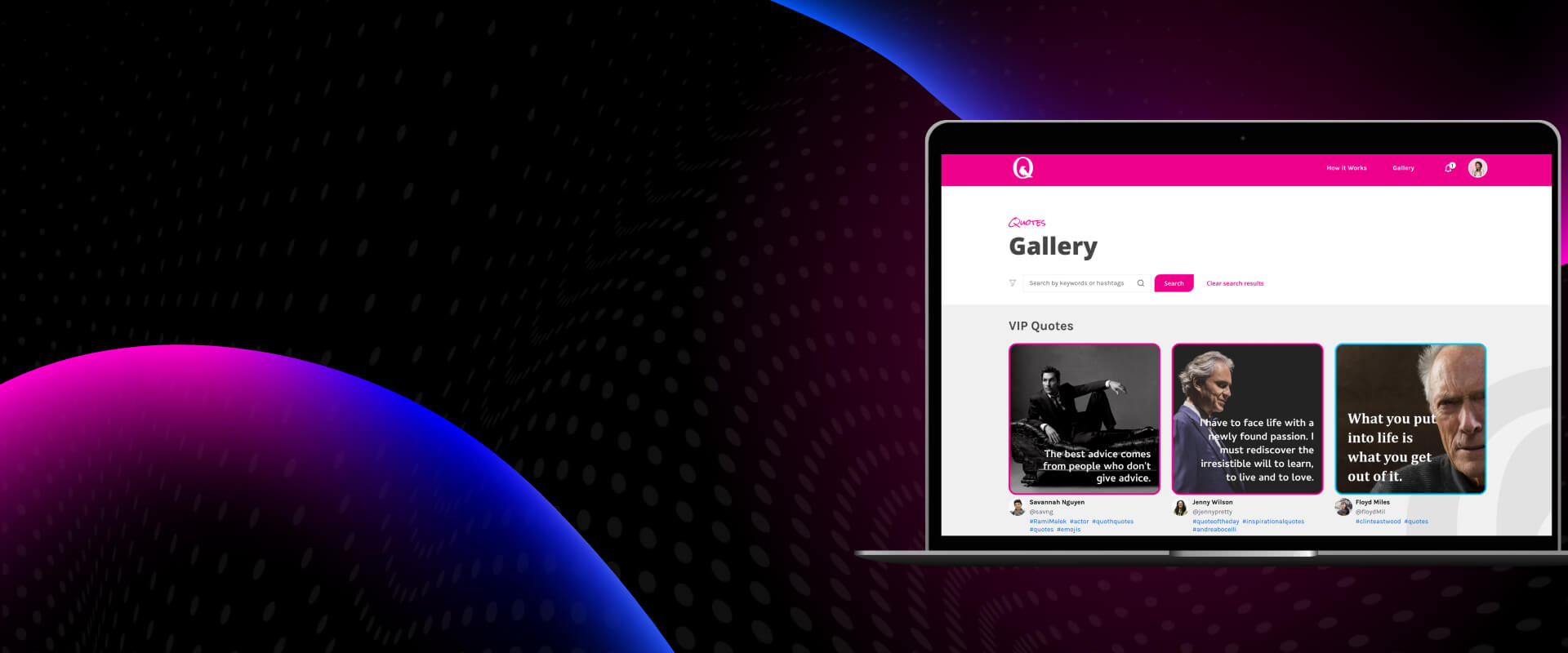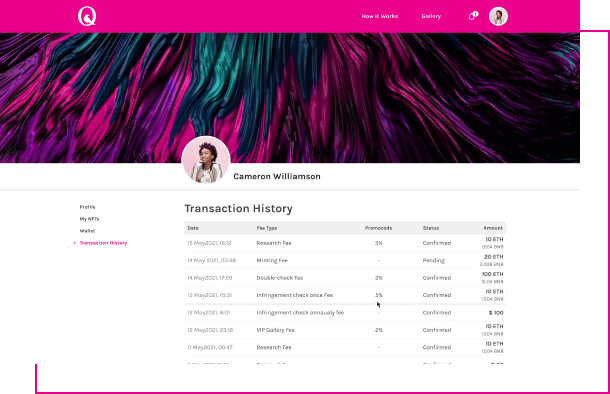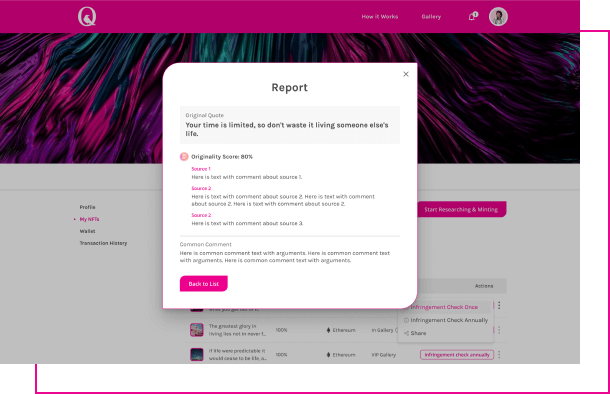
Quoth
Consulting for a Cross-Chain NFT Search Engine Project
- Home
- Success stories
- Quoth
About the client
Our client is a leading figure in the financial services and crypto DeFi community and one of the main contributors to the Enigma blockchain, later transformed into the Secret Network.
The client has an exceptional background in futures trading, blockchain and business consulting. As part of the Enigma project, they used to consult businesses during their transition to blockchain technology and was one of the key players in the conceptualization of the Enigma platform and its features.


Business opportunity
Non-fungible tokens have been a hot topic in the crypto space and the number of NFTs has been growing exponentially. Yet, in spite of their lucrativeness, NFTs have to deal with several challenges, including violated copyright, misquoting, confused authorship, and fake news.
Currently, there is no decent solution that would tackle the burning issue of NFT provenance. The present-day protocols don’t possess the required functionality, therefore it is next to impossible to authenticate the originality of NFTs.
Client’s goals
Considering the aforementioned challenges, the client was set to design a decentralized application that would help authenticate the originality of visual, verbal, and audio content.
Another idea was to provide users with an opportunity to easily create their own NFTs on the platform and effortlessly share them on social media.
In short, the client required the platform that would:
- Ensure copyright protection of videos, images, and songs
- Implement fact-checking for news, media, and research
- Provide a reference for bibliography sources (research papers and essays)
- Protect authorship and copyrighted materials
- Enable social media sharing of quotes from influential people
Work done
- Blockchain architecture ideation
- Development of advanced tokenomics and monetization mechanisms
- Elaboration of user flow, AI tools, and NFT token design
- All-encompassing vision and scope document
- Consulting on the most appropriate tech stack
Details
Discovery phase
First off, our experts analyzed the client’s requirements and ideas to identify which direction should be taken. We fleshed out the project’s purpose, value proposition as well as the client’s expectations. Thanks to these steps, we managed to:
- Elaborate the platform’s functionality
- Determine the core system elements
- Identify user processes and flows

Recommendations on MVP development
Together with the client, we carried out exhaustive market research and identified which features should be included in the initial release (MVP).
Monetization strategies
To help our client extract maximum value from the platform, we’ve also foreseen the implementation of the following monetization strategies:
Research fee
Charged for originality and authenticity checksMinting fee
Charged for generating tokens on the blockchainCustodial wallet fee
Charged from users who prefer to register with an email address and use the platform’s built-in walletReminting fee
Charged for transferring NFTs between blockchains and updating existing NFTsGallery fee
Charged for showcasing the NFTs in the galleryInfringement check fee
Charged for updating the NFT’s originality report to see if it had been used or copied after it was created on the platform

Proposed architecture and tech stack
We suggested going with a microservice architecture with the following main modules dedicated to supporting features and functionality:
Data Validator
The module is responsible for processing data validation requests. Designed with a modular approach allowing to add new providers in the future. Supports both automated providers and manual data processing.
Data Publisher
The module provides the functionality for sending data to the blockchain and IPFS network.
Payment Processor
The module is responsible for accepting payments. Built with a modular approach for the ability to integrate additional payment providers, including payment in cryptocurrencies.
API Service
An interlayer responsible for the interaction between the user interface and back-end system components. It also enables data exchange through REST API.
Data storage and transfers

For data storage and transfers we’ve suggested using:
- PostgreSQL as a database management system
- RabbitMQ as a message broker between services
Third-party tools

The following third-party tools were suggested to support key features:
- AI-powered content validators and anti-plagiarism tools
- IPFS network accessed via nft.storage and pinata.cloud
- Infura or direct connection via RPC to access the blockchain network
The system did not involve any complex processing or computational tasks. With this in mind, we recommended the system to be implemented using the Node.js server and built on top of the Nest.js framework.
Recommendations on blockchain implementation
The client wanted to take advantage of the security and decentralization of modern blockchain networks to create an advanced application. Non-fungible tokens (NFTs) were seen as the perfect tool for authenticating and sharing video, audio, images, and quotes.
We advised using Binance Smart Chain (BSC) for the blockchain platform as it offers distinct advantages:
- BSC provides the highest liquidity on the market for NFT tokens
- Binance fees on transactions are much lower than those on Ethereum
- The platform’s architecture enables high transaction speeds

User flow and processes
After careful consideration and assessment, our team introduced the following user flow to accomplish key project goals:
1
The NFT creator submits the content of the quote and pays the research fee
2
The system checks for NFT duplicates already created on all NFT capable blockchains
3
If the quote has not been yet created, the user pays a minting fee
4
Before being minted, the quote goes through a verification stage and is checked by AI tools and automated plagiarism systems
5
If the plagiarism reports reveal mixed results, the quote goes through an additional approval process by the decentralized community
6
After the research stage is complete, the NFT is minted and the final report is published alongside for the users to view
7
The NFT quote is added to the user’s collection and they can choose to publish it on social media, showcase it in the gallery, or trade it for other NFTs

Results
PixelPlex performed a detailed analysis of the customer’s goals and requirements to determine the core system elements and implementation strategies.
Our team elaborated the platform’s MVP functionality, user flows, and processes while offering recommendations on optimal monetization mechanisms, project architecture, and tech stack.
As a result of our collaboration, the client received comprehensive research and a detailed vision and scope document, which can be further used to start the project smoothly.
Services
We offer a comprehensive range of services, including IT consulting, custom software development, and specialized expertise in blockchain, machine learning, and data science.
Blockchain Development
Blockchain Development
Smart Contract Development
Web3 Development
Crypto Payment Solutions
Tokenization Services
Protocols
Protocols
Cryptocurrency Exchange Development
Cryptocurrency Development
Top Development Company
Blockchain Consulting
Top Blockchain Consulting Company
Custom Software Development
Mobile App Development
Web Development
Top IT Services Company
IT Consulting
Top Consulting Company
ML Development
Artificial Intelligence Development
Machine Learning Development
Data Science Development
Top BI & Big Data Company
AR & VR Development
AR & VR Development
QA & Software TestingQA & Software Testing Services
UI/UX DesignGive us the pleasure of adding our secret sauce to your app.
We’ll create beautiful screens at the front while breaking the limits of what’s behind them to help your app get to beyond-plausible business achievements.
UI/UX Design Services
MVP DevelopmentValidate your product idea quickly with an MVP—launch faster, test smarter, and refine based on real user feedback.
Leverage our expertise in MVP development to build a scalable, market-ready product with minimal risk and maximum efficiency.
MVP Development Services
Metaverse Consulting & DevelopmentValidate your immersive concept quickly with metaverse development — launch your virtual experience, gather actionable user insights on core features like avatars and social interaction, and iterate based on real-world engagement.
Top Development Company
Solutions
RWA PlatformTokenization makes it easier to trade assets and opens up new investment opportunities and diversifies portfolio.
RWA Platform
Asset tokenization platform development
Arbitrage BotProfit from market inefficiencies with automated, customized trading strategies that boost returns and minimize risk.
Arbitrage Bot
Be a transaction ahead. Catch profit at short notice
CryptoAPIGain an unfair data edge for your dApps. Tap into high-quality blockchain insights to outsmart competitors and fuel smarter decisions.
CryptoAPI
Connect your dApps to blockchain networks in a flash
OTC HawkOffer high-net-worth clients a secure, enterprise-grade trading terminal. Streamline deals, enhance reliability, and optimize top-tier crypto assets.
OTC Hawk
Benefit from our portfolio and wealth management app
DocFlowManage sensitive documents on blockchain. Leverage optional zero-knowledge proofs for trust, privacy, and streamlined workflows.
DocFlow
Intuitive Blockchain-Powered Document Management System
Know-Your-TransactionEnsure every transaction is above board. Monitor digital asset flows for compliance and transparency, supporting both businesses and regulators.
KYT crypto platform
Our KYT platform fosters integrity of financial ecosystems
Industries
We work across a variety of industries, from FinTech to eCommerce, leveraging our accumulated knowledge and best practices to deliver solutions tailored to the unique needs of your business.
FinTech & BankingAs traditional finance goes digital, we are committed to building efficient ecosystems and better engagement.
Think of customized FinTech solutions with tamper-proof transactions and storage, progress transparency and automation — and we’ll make them see the light of day.
$25T
Global Financial Services
20%
Digital/Blockchain Growth
Solutions for FinTech & Banking
Retail & eCommerceWhether you market B2B or B2C, commerce tech trends are all about value-driven purposes, global sustainability, hybrid shopping journeys, and extra-resiliency.
Let your clients know that there’s more to your brand than meets the eye by creating unique customer experiences in all your stores.
$6.3T
Global eCommerce
10-15%
Tech Innovation Growth
Solutions for Retail & eCommerce
Supply Chain & LogisticsTo make things easier for all vendors, we deliver apps for route and cost optimization, vehicle operational support, and better dispatch time efficiency.
With focus is sustainability, resilience, transparency, and immutability, let’s get your transformation going.
$10T
Global Logistics
15-20%
Blockchain Adoption Growth
Solutions for Supply Chain & Logistics
HealthcareCustom healthcare software solutions are aimed at helping you ensure accurate diagnosis, better patient engagement, and positive healthcare outcomes.
Whether you require a patient management solution, practice management software, EMR/EHR system, or ML-enabled diagnostics – we’ve got you covered.
$10T
Global Healthcare
20%
Digital/Blockchain Growth
Solutions for Healthcare
Real EstateKeep up with digital innovation trends by accelerating enterprise transformation and scaling, leveraging data and orchestrating workflows.
Whether you manage and sell commercial facilities or invest third-party capital, our integrated solutions help you make the most of it.
$340T
Global Real Estate
15%
PropTech/Blockchain Growth
Solutions for Real Estate
Oil & GasWith mobility and digital technologies standing to change the game and define leadership, our mission is to get you digital-first.
Resolve operational and conceptual issues by introducing clear tech vision, feasible architectures, and flexible software to take business extension off limits.
$4T
Global Oil & Gas Industry
10-15%
Digital/Blockchain Growth
Solutions for Oil & Gas Industry
InsuranceImagine a world where quoting policies, processing claims, and managing mountains of paperwork are effortless. PixelPlex can help you achieve just that.
Break free from outdated systems and focus on what truly matters – delivering exceptional service to your policyholders and growing your insurance business.
$25T
Global financial services
20%
Digital/blockchain growth
Solutions for Insurance Industry
FitnessWe create custom fitness software solutions that support meaningful training and steady engagement from the first session.
If you’re building a digital product for active users and need a team with real project experience behind it, we’ll help you bring it to life with clarity and purpose.
$257B
Global Fitness Industry
24%
Digital Growth
Solutions for Fitness
Success stories
Domain
Industry
Protocols
Company
About us Team Careers Social Responsibility ContactsBlog
Blockchain Big Data Artificial Intelligence AR/VR Mobile News View Blog